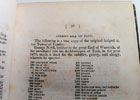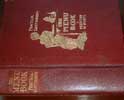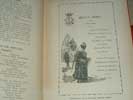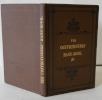Apician Morsels;
OR, TALES OF THE TABLE, KITCHEN, AND LARDER: CONTAINING A NEW AND IMPROVED CODE OF EATICS; SELECT EPICUREAN PRECEPTS; NUTRITIVE MAXIMS, REFLECTIONS, ANECDOTES, &C. ILLUSTRATING THE VERITABLE SCIENCE OF THE MOUTH; WHICH INCLUDES THE ART OF NEVER BREAKFASTING AT HOME, AND ALWAYS DINING ABROAD. BY DICK HUMELBERGIUS SECUNDUS. "O vow qui stomach Iaboatis, accurate, et ego vow restaurabo!" Vide p.106. "Always breakfast as if you did not intend to dine; and dine as if you had not broken your fast." -- Code Gourmand. New York: PRINTED BY J. & J. HARPER, 82 CLIFF-ST. SOLD BY COLLINS AND HANNAY, COLLINS AND CO., G. AND C. AND H. CAR-VILL., W. B. GILLEY , E. BLISS, AND O. A. ROORBACH; --PHILADELPHIA. CAREY, LEA, AND CARRY, J. GRIGG, TOWAR AND HOGAN, U. HUNT, R.. COWPERTHWAITE, E. LITTELL, AND BROTHERS, AND M'CARTY AND DAVIS; -- ALBANY, O. STEELE. 1829.
12mo. 190X116mm. Paste-down and end-paper marbled paper. [1] 1fep. [1] Frontispiece of Mr Eatingtown. Title page. [1] 2p Contents, xxv chapters. [2]9-212. 1fep. [1] End-paper and paste-down marbled paper. Half tan calf with black and tan speckled paper boards with nice patina. the spine has raised bands, gilt lines and gilt tooled devices. with a red label and gilt lettering. Internally very lightly age-browned throughout. A scarce book.
- Dick Hemelbergius Secundus, was actually a sixteen-century annotator named Gabriel Hummelberger making a comeback in this tome of 1829. In 'The Literary Gazette and Journal' for the year 1829, in the book review section, the critic pans the author of 'Apician Morsels' for his performance as not equal to that of a true man. He further takes an arrogant broadside at the author and other scribes of the day, for their use of French or other languages, which they do not understand. He goes further, boldly stating --- "Their style is as full of French and other phrases as a plum pudding is of plums and currants -- you cannot tell which is the radical tongue or the principal ingredient. It might be supposed that the English was copious enough to express all the ideas of the learned, imaginative, and highly gifted, and infinitely too copious to be needed by these literary shrimps, who have neither original thought nor ideas of any kind to express; ----- of these faults our Apician scribe affords us plenty of specimens". Strong stuff indeed. Apician Morsels; or Tales of the Table, Kitchen and Larder has been attributed to the Gothic novelist William Beckford, though others suspect the hand of Richard Chenevix, reviewer for the Edinburgh Review, (which may account for the venom in the critique of The Literary Gazette). 'Apician Morsels' announces "a New and Improved Code of Eatics," with "Select Epicurean Precepts," and "Nutritive Maxims, Reflections, Anecdotes . . . illustrating the Veritable Science of the Mouth." In addition to original essays on various aspects of cookery and good-living, Humelbergius takes his "Nutritive Varieties" (without attribution) from Grimod, along with other treatments of meals, invitations, and bonne chère.






click on image to enlarge

Antiquarian category
ref number:
11154 












































